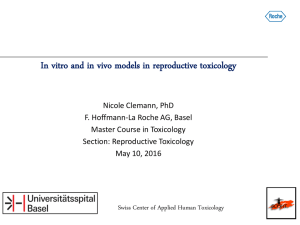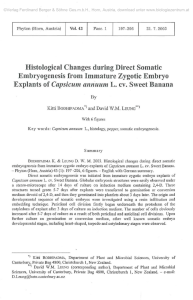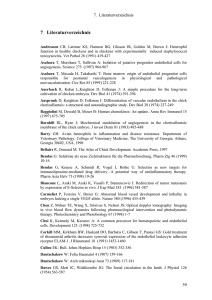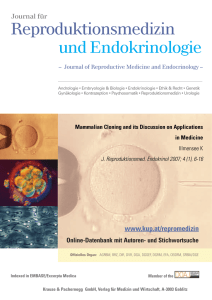Day 4 embryo selection is equal to Day 5 using a new embryo
Werbung
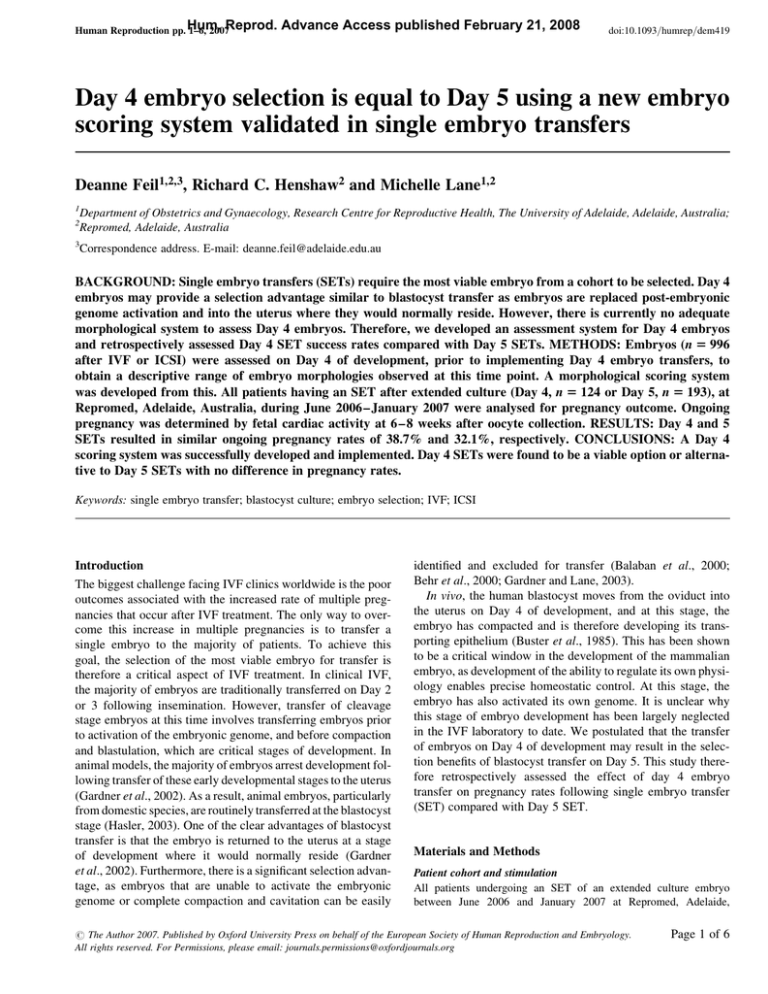
Human Reproduction pp. Hum. 1–6, 2007Reprod. Advance Access published February 21, 2008 doi:10.1093/humrep/dem419 Day 4 embryo selection is equal to Day 5 using a new embryo scoring system validated in single embryo transfers Deanne Feil1,2,3, Richard C. Henshaw2 and Michelle Lane1,2 1 2 3 Department of Obstetrics and Gynaecology, Research Centre for Reproductive Health, The University of Adelaide, Adelaide, Australia; Repromed, Adelaide, Australia Correspondence address. E-mail: [email protected] BACKGROUND: Single embryo transfers (SETs) require the most viable embryo from a cohort to be selected. Day 4 embryos may provide a selection advantage similar to blastocyst transfer as embryos are replaced post-embryonic genome activation and into the uterus where they would normally reside. However, there is currently no adequate morphological system to assess Day 4 embryos. Therefore, we developed an assessment system for Day 4 embryos and retrospectively assessed Day 4 SET success rates compared with Day 5 SETs. METHODS: Embryos (n 5 996 after IVF or ICSI) were assessed on Day 4 of development, prior to implementing Day 4 embryo transfers, to obtain a descriptive range of embryo morphologies observed at this time point. A morphological scoring system was developed from this. All patients having an SET after extended culture (Day 4, n 5 124 or Day 5, n 5 193), at Repromed, Adelaide, Australia, during June 2006–January 2007 were analysed for pregnancy outcome. Ongoing pregnancy was determined by fetal cardiac activity at 6–8 weeks after oocyte collection. RESULTS: Day 4 and 5 SETs resulted in similar ongoing pregnancy rates of 38.7% and 32.1%, respectively. CONCLUSIONS: A Day 4 scoring system was successfully developed and implemented. Day 4 SETs were found to be a viable option or alternative to Day 5 SETs with no difference in pregnancy rates. Keywords: single embryo transfer; blastocyst culture; embryo selection; IVF; ICSI Introduction The biggest challenge facing IVF clinics worldwide is the poor outcomes associated with the increased rate of multiple pregnancies that occur after IVF treatment. The only way to overcome this increase in multiple pregnancies is to transfer a single embryo to the majority of patients. To achieve this goal, the selection of the most viable embryo for transfer is therefore a critical aspect of IVF treatment. In clinical IVF, the majority of embryos are traditionally transferred on Day 2 or 3 following insemination. However, transfer of cleavage stage embryos at this time involves transferring embryos prior to activation of the embryonic genome, and before compaction and blastulation, which are critical stages of development. In animal models, the majority of embryos arrest development following transfer of these early developmental stages to the uterus (Gardner et al., 2002). As a result, animal embryos, particularly from domestic species, are routinely transferred at the blastocyst stage (Hasler, 2003). One of the clear advantages of blastocyst transfer is that the embryo is returned to the uterus at a stage of development where it would normally reside (Gardner et al., 2002). Furthermore, there is a significant selection advantage, as embryos that are unable to activate the embryonic genome or complete compaction and cavitation can be easily identified and excluded for transfer (Balaban et al., 2000; Behr et al., 2000; Gardner and Lane, 2003). In vivo, the human blastocyst moves from the oviduct into the uterus on Day 4 of development, and at this stage, the embryo has compacted and is therefore developing its transporting epithelium (Buster et al., 1985). This has been shown to be a critical window in the development of the mammalian embryo, as development of the ability to regulate its own physiology enables precise homeostatic control. At this stage, the embryo has also activated its own genome. It is unclear why this stage of embryo development has been largely neglected in the IVF laboratory to date. We postulated that the transfer of embryos on Day 4 of development may result in the selection benefits of blastocyst transfer on Day 5. This study therefore retrospectively assessed the effect of day 4 embryo transfer on pregnancy rates following single embryo transfer (SET) compared with Day 5 SET. Materials and Methods Patient cohort and stimulation All patients undergoing an SET of an extended culture embryo between June 2006 and January 2007 at Repromed, Adelaide, # The Author 2007. Published by Oxford University Press on behalf of the European Society of Human Reproduction and Embryology. All rights reserved. For Permissions, please email: [email protected] Page 1 of 6 Feil et al. Australia, were included in this study (n ¼ 317), excluding treatment cycles that incorporated donor gametes or pre-implantation genetic diagnosis. All patients were stimulated using a long down-regulation protocol involving the administration of a GnRH analogue [Nafarelin (Synarel), Pfizer, Australia] with down-regulation confirmed with blood estrogen levels below 0.2 nM/l. Patients were then administered recombinant FSH (Gonal-F, Serono, Sydney, Australia or Puregon, Organon, Sydney, Australia, doses ranging from 150 to 300 IU) for 9–12 days, monitored by ultrasound and serum hormone levels, until the lead follicle was a size of 18 mm. Patients were then given HCG (5000 IU, Pregnyl, Organon, Sydney, Australia) and the oocyte collection scheduled for 36 h later. Cumulus–oocyte complexes (COCs) were aspirated from follicles .14 mm using transvaginal ultrasound and a 17 gauge needle. Laboratory procedures All media and oil products were purchased from Vitrolife, Kungsbacka, Sweden, unless otherwise indicated. All embryo culture was performed at 378C, 6% CO2, 5% O2 and 89% N2, in a humidified atmosphere. COCs were isolated from follicular fluid and washed in glucose supplemented (2.5 mM glucose) GFERT Plus medium. For IVF insemination, COCs were trimmed of their outer layers of cumulus cells and co-incubated with 5000 motile sperm in 50 ml drops of glucose supplemented GFERT Plus under oil for 17 –19 h. For ICSI insemination, COCs were denuded in 75 IU Hyaluronidase (Hyalasew, Aventis Pharma Pty Ltd, Lane Cove, Australia) in glucose supplemented GFERT and then ICSI performed in G1.3 Plus medium and cultured in groups of up to four embryos, in 50 ml drops of the same medium under oil for 16– 18 h. The following morning, IVF oocytes were denuded and washed thoroughly through G1.3 Plus medium. For both IVF and ICSI, fertilization was assessed and all embryos with two pronuclei present were cultured in groups of up to four embryos in 50 ml drops of G1.3 Plus medium under oil for the next 48 h. On Day 3 of embryo culture, all embryos were washed thoroughly through G2.3 Plus medium and cultured in groups of up to four embryos in 50 ml drops of the same medium for another 48 h (Day 5), at which point embryos were transferred to fresh G2.3 Plus medium for the final 24 h of culture. Embryo morphology assessment On Day 3, embryo morphology was assessed based on the number and quality of blastomeres, the degree of fragmentation and the presence of multinucleated cells. Good quality embryos were determined to have 7–8 cells (66 + 1 h post-insemination), with ,10% fragmentation and the absence of multinucleated blastomeres. Morphology was initially assessed on Day 4 of culture in a descriptive manner to establish the range of morphologies observed. As a result of this analysis, an in-house scoring system for Day 4 embryos was developed and is described in Fig. 1. Blastocyst development was assessed on Days 5 and 6 as per the grading system described by Gardner and Schoolcraft (1999). Briefly, the degree of expansion and morphology of the inner cell mass and trophectoderm were visually assessed. Independent of the day of transfer, embryo morphology was assessed using a scale of 1– 4, where Grade 1 indicated best morphological quality and Grade 4 indicated a poor morphological quality embryo. Day of transfer Patients consented to have an extended culture (Day 4 or Day 5) transfer in a clinic appointment with their clinician, where all decisions Page 2 of 6 Figure 1: Scoring system developed for Day 4 embryos. Grade 1: early blastocyst, visible signs of cavitation occurring (A) or completely compacted embryo, lacking negative morphological anomalies (B), e.g. vacuolation, excessive fragmentation, large number of excluded cells and self-cavitation of cells. Grade 2: Grade 1 compacted morula, with some morphological anomalies, e.g. one of the following present: vacuolation, excessive fragmentation, excluded cells, self-cavitation of cells or at least an eight-cell embryo, with partial compaction present or the majority of cells at least showing signs of compaction (C and D). Grade 3: partially compacted embryo with vacuoles or excessive fragmentation present or eight-cell embryo or greater, with no signs of compaction evident (E). Grade 4: embryos with eight cells or greater, with no signs of compaction and vacuoles or excess fragments or embryos with less than eight cells, and no signs of compaction (F) regarding the upcoming treatment were decided upon, and consent forms signed to reflect these decisions. After the commencement of treatment and scheduling of the patient for oocyte collection in theatre, embryo transfer appointments were allocated, based on the patient’s own clinician being available for transfer, and avoiding embryo transfers on Sundays. These reasons alone determined whether an extended culture stage transfer was performed on Day 4 or Day 5 of embryo culture. Patients who consented to have an extended culture transfer but had only a single embryo resulting from treatment had their transfer rescheduled to a cleavage stage transfer as there was seen to be no added selection benefit of growing a single embryo to Day 4 or Day 5 before transfer and were excluded from the study analysis. Day 4 embryo transfer Table I. Patient demographic characteristics. Number of patients Maternal age (years) % ICSI Number previous IVF/ICSI cycles Number of oocytes collected Number of immature oocytes collected (ICSI) Percentage fertilized Grade of transferred embryo† Number of surplus embryos frozen Infertility diagnosis % (n)* Male factor Endometriosis Tubal Ovarian Unexplained Other Pregnancy rate‡ 95% confidence intervals Day 4 transfer Day 5 transfer 124 34.8 + 0.4 82.3% 1.25 + 0.14 11.6 + 0.6 0.58 + 0.11 63.3% 1.5 + 0.05a 3.0 + 0.2 193 33.9 + 0.3 81.3% 0.94 + 0.10 11.8 + 0.4 0.95 + 0.10 62.0% 2.2 + 0.08b 2.7 + 0.2 63.6% (70)a 9.1% (10) 13.6% (15) 30.9% (34) 16.4% (18) 8.2% (9) 38.7% (48) 30–48% 68.4% (132)b 9.3% (18) 9.8% (19) 20.7% (40) 12.4% (24) 2.6% (5) 32.1% (62) 26– 39% Variables with statistically significant differences are indicated by different superscripts within a row. *Infertility diagnoses include both male and female diagnoses, in some cases more than one category is applicable to a patient pair. Male factor P ¼ 0.001. It should be noted that different assessment systems were used to score embryos at each of the different days of transfer P ¼ 0.0001. ‡ Numbers in parentheses indicate the number of patients with an ongoing pregnancy. † Embryo transfers Embryo selection for transfer was based on assessment of morphology, and in all cases the single highest quality embryo, as determined by the scoring system applicable to the stage of embryo development, dependent on the day of transfer (Day 4 or Day 5 of embryo culture), was transferred. Embryos selected for transfer were incubated in EmbryoGluew for 0.5– 4 h before transfer and transferred into the uterus in a volume of approximately 10 ml, under ultrasound guidance. Pregnancy assessment An ongoing clinical pregnancy was defined as the presence of an intrauterine fetal heart beat by ultrasound 6–8 weeks after oocyte collection. Statistics Data are presented as percentages or mean + SEM, where appropriate. Data were analysed by either a x2 test or one way analysis of variance. Bonferroni post hoc tests were applied for normally distributed data, whereas Dunnett’s T3 post hoc tests were applied for data that were not normally distributed. Linear regression of pregnancy rates resulting from the transfer of embryos of different grades on Day 4 of culture was assessed using a Pearson correlation coefficient test. P-values of ,0.05 were considered to be statistically significant. Results Patient demographics Patient demographic characteristics are shown in Table I. There was no difference in maternal age between treatment groups of Day 4 or Day 5 embryo transfer (34.8 + 0.4 and 33.9 + 0.3 years, respectively). The number of previous cycles undergone by patients, the rates of ICSI and IVF, the number of oocytes collected and rate of fertilization in the different embryo transfer day groups were also not significantly different (Table I). The number of immature oocytes determined following aspiration for patients undergoing ICSI was similar between the groups (Table I). The grade of embryos transferred on Day 5 (2.2 + 0.08) was significantly lower than the grade of transferred embryos on Day 4 (1.5 + 0.05, P ¼ 0.0001), which is not unexpected due to the use of different assessment systems to grade the embryos. There was no difference in the number of embryos frozen when patients had their embryo transfer on Day 4 compared with Day 5 (3.0 + 0.2 and 2.7 + 0.2, respectively). During the time period of this study, there were no extended culture embryo transfers cancelled, provided at least two oocytes fertilized. Patients whose most advanced embryo is a compacted morula on Day 5 have this transferred in preference to cancelling their transfer, as in our unit even these slower embryos have a 25% ongoing pregnancy rate (unpublished data). Embryo morphology observed on Day 4 The range of embryo morphologies observed for 996 embryos assessed on Day 4 is described in Fig. 2. There was a large range of developmental stages observed. The majority of embryos were yet to compact, or arrested (n ¼ 517, 51.9%). However, 46.9% of the embryos observed were either partially or completely compacted (n ¼ 469, Fig. 2). As previously mentioned, a Day 4 morphology scoring system was developed in our clinic to reflect the range of embryo morphologies observed, and select the highest quality embryo for transfer (Fig. 1). Pregnancy rates Pregnancy rates for the newly developed Day 4 scoring system with regard to embryo grade are shown in Fig. 3. A linear decrease in pregnancy rate with grade was observed on Day 4 of culture (R 2 ¼ 0.972, P , 0.05). Interestingly, embryos with partial compaction on Day 4 were shown to be as viable as completely compacted embryos when transferred (37.1% compared with 40% ongoing pregnancy, respectively), and as such have been included in the scoring system as eligible for Page 3 of 6 Feil et al. Figure 4: Day 4 and Day 5 SET Ongoing Pregnancy Rates. Error Bars indicates 95% Confidence intervals Figure 2: Range of morphologies observed on Day 4 of embryo development Figure 3: Pregnancy rates using developed Day 4 scoring system with signal embryo transfers. Numbers in columns indicate the number of single embryo transfers performed in each group assignment as a Grade 2 embryo, providing no additional morphological anomalies are present. There was no difference in the overall ongoing pregnancy rates for SETs on Days 4 and 5 (38.7% and 32.1%, respectively, P ¼ 1.0, Fig. 4). Day 4 embryo transfers resulted in a 47.9% pregnancy rate in patients with a maternal age ,38 years compared with 10% in patients 38 years. In comparison, patients ,38 years having a Day 5 embryo transfer had an ongoing pregnancy rate of 37.2%, whereas those 38 years had an 11.1% pregnancy rate. The Day 4 embryo transfers for patients ,38 years tended to have a higher pregnancy rate, although this was not significant, compared with Day 5 embryo transfers in the same age group (P ¼ 0.118, Fig. 5). Discussion The ability to select the most viable embryo for transfer is an increasingly important aspect to an IVF cycle. Key considerations for selection of the most viable embryos include that Page 4 of 6 Figure 5: Effect of Maternal Age and Day of Transfer on Pregnancy Rates with single Embryo Transfers. Error bars indicates 95% Confidence intervals the assessment be non-invasive and that it occurs in a timely fashion that can easily occur within the operations of the clinical laboratory. As such, methods to increase selection that are based on embryo morphology are an attractive option. Our data, although observational and retrospective, suggest that transfer of Day 4 human embryos is a viable alternative to the transfer of embryos on Day 5. The selection advantage that is well documented for extended culture was observed in our study with embryo selection being maintained with a Day 4 embryo transfer, across unselected patients. Our clinic therefore continues to perform both Days 4 and 5 embryo transfers for patients wishing for their embryos to undergo extended culture, based on clinic, patient and laboratory requirements. Our study is unique to the current literature as it is the first to analyse pregnancy rates following the transfer of single embryos on Day 4 of development. Previous studies (Huisman et al., 2000; Tao et al., 2002; Margreiter et al., 2003; Skorupski et al., 2007) did not perform SETs, with up Day 4 embryo transfer to four embryos being transferred to the uterus at one time, making the determination of which embryos resulted in viable implantations difficult. By performing SETs, we have been able to trace the fate of individual embryos and therefore compile a robust scoring system to enhance selection. All extended culture SETs performed in our clinic were included in this study, excluding cycles that involved donor gametes or pre-implantation genetic diagnosis. Although patients included in the analysis for this study were non-selected, it must be noted that our clinic has a Single Embryo Transfer Policy, which recommends patients under the age of 38 have a single embryo transferred. However, unlike previous studies, the decision of whether a patient would have a transfer following extended culture was not based on the patient’s response to gonadotrophins or embryo quality at the cleavage stage. Rather, this decision was made clinically, prior to the commencement of the patient’s treatment. Patients were only converted from an extended culture transfer to a cleavage stage transfer in the event that there was no selection advantage to be gained by growing embryos for an extended period, i.e. only one embryo was available for transfer. One of the key advantages of a Day 4 embryo assessment appears to be in the wide range of observed embryo development on Day 4, from cleavage stages through to early blastocysts. Therefore, it appears that this is a dynamic time period of development and we suggest that the increase in pregnancy rate observed may result from the assessment at this time assisting in selection of an ‘on-time’ developing embryo. A further advantage of Day 4 morphology is that the embryo scoring system is an extension of a cleavage stage scoring system. Therefore, an embryo can be selected for transfer more quickly with the added benefit that there is no requirement for extra training that is necessary with blastocyst embryo selection for transfer. Day 4 embryo selection provided no additional advantage over Day 5 embryo transfer in this study. A previous study combining Days 4 and 5 transfers from a prospective randomized multi-centre study found an increase in implantation rate compared with Days 2/3 transfers (Margreiter et al., 2003); however, Days 4 and 5 pregnancy rates were reported as one result in this study, so a true comparison of Days 4 and 5 pregnancy rates cannot be made. A demonstrated benefit of blastocyst culture and transfer is the ability to determine which embryos have not yet activated the embryonic genome, which occurs at the 4 – 8 cell stage in the human (Braude et al., 1988). Thus, those embryos with limited developmental potential in a cohort can be identified and excluded. We, and others (Huisman et al., 2000; Tao et al., 2002; Skorupski et al., 2007), have demonstrated this increased selection power is still evident with a Day 4 embryo transfer. One potential benefit of the use of Day 4 embryo transfers is the reduction in the time that an embryo exists ex vivo. It has been suggested that extending the time that an embryo is in culture may increase the susceptibility to disruption of epigenetic regulatory processes. The use of Day 4 selection and transfer may reduce this susceptibility. The implementation of embryo transfers on Day 4 of development has given our laboratory flexibility to enable transfers to be scheduled to suit both the clinic and the patient. The overall laboratory impact has been extremely minimal, as only the transfer occurs on Day 4 with freezing still being performed on Days 5 and 6. Thus, the introduction of Day 4 embryo transfers was purely a mechanism to improve the management of treatment by providing flexibility for the patient, their clinician and the laboratory. Freezing of morula on Day 4 has been investigated (Tao et al., 2004) and we are also looking at implementing this technique in our laboratory. The transfer of Day 4 embryos is beneficial in numerous ways; the embryo is returned to the uterus, to an environment where it would normally reside. This occurs post-genome activation to allow the embryo with the highest developmental potential to be selected from a cohort. An added advantage is being exposed to the uterine environment for the maximum time period, and an in vitro environment for a minimal time period, before implantation. In addition, uterine contractility is reduced at this time, all of which maximizes the potential for implantation (Fanchin et al., 1998; Lesny et al., 1998). The ability to transfer the embryo to the uterus on Day 4 enables the benefits of embryo selection for transfer postgenome activation to be obtained, and may offer a viable alternative to Day 5 transfers. It also has the advantage in a busy unit to enable flexibility as to the day of embryo transfer, on Day 4 or 5, without affecting ongoing pregnancy rates. Day 4 embryo selection appears to be an effective tool to maintain the pregnancy rates achieved with Day 5 embryo transfer, and as such we continue to perform Day 4 embryo transfers to enable flexible treatment for our patients. In order to further validate these observational data, a prospective randomized study should be undertaken to determine if Day 4 transfers result in improved pregnancy outcomes. A power analysis based on the preliminary data in this study, for patients with a maternal age ,38 years, indicates for a prospective study 226 patients would be required in each arm of the study to detect a significant difference between Day 4 and Day 5 embryo transfers. Funding This work was supported by a National Health and Medical Research Council (NHMRC) project grant awarded to M.L. D.F. is the recipient of a NHMRC Dora Lush Biomedical Research Scholarship and M.L. is the recipient of a R.D. Wright Fellowship from the NHMRC. References Balaban B, Urman B, Sertac A, Alatas C, Aksoy S, Mercan R. Blastocyst quality affects the success of blastocyst-stage embryo transfer. Fertil Steril 2000;74:282– 287. Behr B, Fisch JD, Racowsky C, Miller K, Pool TB, Milki AA. Blastocyst-ET and monozygotic twinning. J Assist Reprod Genet 2000;17:349– 351. Braude P, Bolton V, Moore S. Human gene expression first occurs between the four- and eight-cell stages of preimplantation development. Nature 1988;332:459–461. Buster JE, Bustillo M, Rodi IA, Cohen SW, Hamilton M, Simon JA, Thorneycroft IH, Marshall JR. Biologic and morphologic development of donated human ova recovered by nonsurgical uterine lavage. Am J Obstet Gynecol 1985;153:211– 217. Page 5 of 6 Feil et al. Fanchin R, Righini C, Olivennes F, Taylor S, de Ziegler D, Frydman R. Uterine contractions at the time of embryo transfer alter pregnancy rates after in-vitro fertilization. Hum Reprod 1998;13:1968–1974. Gardner DK, Schoolcraft WB. In vitro culture of human blastocysts. In: Jansen R, Mortimer D (eds). Towards Reproductive Certainty: Fertility and Genetics Beyond 1999. Carnforth, UK: Parthenon Publishing, 1999,378–388. Gardner DK, Lane M. Blastocyst transfer. Clin Obstet Gynecol 2003;46:231–238. Gardner DK, Lane M, Schoolcraft WB. Physiology and culture of the human blastocyst. J Reprod Immunol 2002;55:85– 100. Hasler JF. The current status and future of commercial embryo transfer in cattle. Anim Reprod Sci 2003;79:245–264. Huisman GJ, Fauser BC, Eijkemans MJ, Pieters MH. Implantation rates after in vitro fertilization and transfer of a maximum of two embryos that have undergone three to five days of culture. Fertil Steril 2000;73:117–122. Lesny P, Killick SR, Tetlow RL, Robinson J, Maguiness SD. Uterine junctional zone contractions during assisted reproduction cycles. Hum Reprod Update 1998;4:440– 445. Page 6 of 6 Margreiter M, Weghofer A, Kogosowski A, Mahmoud KZ, Feichtinger W. A prospective randomized multicenter study to evaluate the best day for embryo transfer: does the outcome justify prolonged embryo culture? J Assist Reprod Genet 2003;20:91 –94. Skorupski JC, Stein DE, Acholonu U, Field H, Keltz M. Successful pregnancy rates achieved with day 4 embryo transfers. Fertil Steril 2007;87:788–791. Tao J, Tamis R, Fink K, Williams B, Nelson-White T, Craig R. The neglected morula/compact stage embryo transfer. Hum Reprod 2002;17:1513– 1518. Tao J, Craig R, Johnson M, Williams B, Lewis W, White J, Buehler N. Cryopreservation of human embryos at the morula stage and outcomes after transfer. Fertil Steril 2004;82:108– 118. Submitted on April 6, 2007; resubmitted on December 6, 2007; accepted on December 13, 2007






